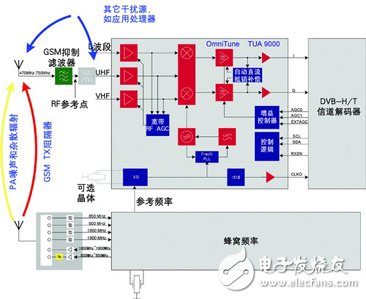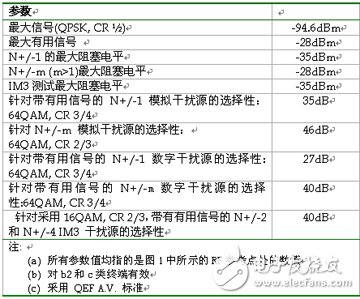As digital mobile TV continues to shift to mobile device applications, application and system engineers are facing challenges such as miniaturization of form factor, lower power consumption, and signal integrity. The research focus on existing mobile TV standards will be placed on DVB-H. This article will discuss the opportunities and challenges of DVB-H receiver design from a system perspective, and focus on the RF front-end.
Mobile TV standard
Table 1 lists existing and upcoming mobile TV standards and systems (excluding cellular standards such as MBMS and BCMCS) without guaranteeing completeness.
DVB-H is built on DVB-T and is backward compatible, allowing DVB-H signals to be transmitted over existing DVB-T channels. The biggest changes are the addition of 4k FFT mode, deep interleaving for 2k and 4k OFDM, another forward error correction layer (MPE-FEC) for multi-protocol encapsulated data, and time segments to save power. Italy has started commercial services for DVB-H, and many other countries will be put into commercial use in 2007/2008.
QUALCOMM has developed FLO (Forward Link) technology as the basis for MediaFLOTM and will be operational in North America. Similar to DVB-H, FLO effectively reduces power consumption by using time segments.
T-DMB was developed based on the Eureka 147DAB standard and is widely used in Korea. South Korea's mobile satellite system S-DMB is one of the few systems that do not use OFDM. S-DMB uses Code Division Multiple Access (CDM) technology and operates on a 25 MHz wide S-band channel.
Japan has been using the ISDB-T standard to provide mobile TV services since 2006. The standard uses a 6MHz channel to provide mobile services.

Table 1: Comparison of various mobile TV standards
China recently issued its own mobile broadcast service standard called CMMB (China Multimedia Mobile Broadcasting). A key part of CMMB is STIMi (Satellite Terrestrial Interactive Multi-Service Infrastructure), the physical layer based on OFDM technology. China also announced the adoption of the DMB-TH (Digital Multimedia Terrestrial Broadcast/Mobile) digital TV standard for mobile phones.
Not long ago, the DVB decision-making body (SteeringBoard) approved the DVB-SH (Mobile Satellite Service) specification. DVB-SH provides services to mobile devices via satellite and terrestrial hybrid networks, which connect satellites directly to mobile transmitting devices and terrestrial repeaters. DVB-SH can be subdivided into two standards, SH-A and SH-B. In SH-A, both satellite and terrestrial links use COFDM technology. In SH-B, the satellite link uses TDM and the terrestrial link uses COFDM. DVB-SH demonstrated at the 3GSM Global Conference in Barcelona earlier this year.
RF interface requirements for DVB-H
Currently DVB-H is recognized as the leading standard for mobile TV worldwide. This article will focus on the DVB-H standard, although other standards have a certain market. A number of key parameters associated with the analog and radio frequency portions of the mobile terminal receiver are summarized in Table 2.
For DVB-H, the zero-IF direct conversion receivers shown in Figure 1 have become mainstream architectures because they meet the specifications given in Table 2 and require the fewest external components and power consumption. Very low.

Figure 1: DVB-H front end embedded in a cellular environment

Table 2: Key Indicators for DVB-H Mobile Terminal RF Interface
Another low-IF architecture is plagued by the stringent image rejection requirements imposed by N+/-1 blockers. Thanks to the use of advanced CMOS technology, various mixed signal correction and circuit techniques can be used to overcome some of the obvious shortcomings of the zero-IF direct conversion architecture, such as DC bias. The high bandwidth and large subcarrier frequencies used by DVB-T and DVB-H can reduce the spectrum in the range of several kHz near the DC signal without significantly affecting performance.
In addition, as the new product TUA9000 demonstrates, despite the wide input frequency range required for DVB-H, it is possible to integrate a low noise amplifier (LNA) on a pure CMOS tuner. Since the system noise value at the RF reference point is less than 3.5 to 4 dB, the required sensitivity is fully achieved.
Mobility
The mobile nature of the terminal can cause a rapidly changing channel and the Doppler shift of the received signal and its echo. Receiver performance under these conditions is highly dependent on the standard modulation and protection methods employed and the performance of the signal processing algorithms. DVB-H is highly immune to these signal impairments and can be adjusted to meet actual requirements through a number of different configurations. Due to the excellent AGC concept and sufficient C/N margin, the effects of the analog tuner section are generally quite small.
System implementation considerations
The recovery of mobile TV signals in mobile environments often encounters various signal impairment issues including specific system integration.
Considering the high bandwidth of UHF receivers and the limited length of mobile terminal antennas, antenna design is extremely challenging. If the antenna is designed as a wideband antenna, the gain achieved is naturally lower, which seriously affects the link budget. Although the low noise receiver design can alleviate this problem to a certain extent, the antenna is still the best "low noise amplifier" in the system. It is therefore best to look for alternative antenna solutions. Tuned or resonant antennas can provide better performance. However, nonlinear tuning components such as varactor diodes reduce the useful signal quality when there is a strong GSM transmit signal in the environment because the isolation between the cellular antenna and the DVB-H antenna is only 10-20 dB.
Pin Header Connector,Pin Header Female,Male Header Pins,Right Angle Pin Header
Cixi Xinke Electronic Technology Co., Ltd. , https://www.cxxinke.com